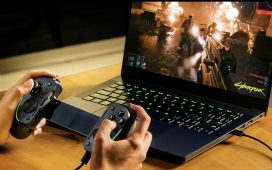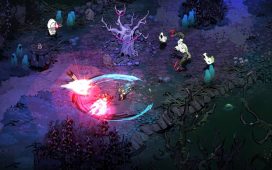Ninja Theory’s Hellblade: Senua’s Sacrifice was my favorite game of 2017. It was also relentlessly dark. And I can see why Ninja Theory’s next game, Bleeding Edge, is a goofy co-op title.
Bleeding Edge pits four players in control of cartoon cyberpunk characters against four other human players. They ride hoverboards into battle and sport wacky outfits and tattoos. It’s a third-person action combat title with competitive online team gaming. The combat system rewards technique, timing, and teamwork in cyberpunk arenas that feature hazards like trains that come through the battlefield.
I spoke with executive producer Rahni Tucker about Bleeding Edge at the Electronic Entertainment Expo (E3), the big game trade show in Los Angeles. I also played the game and found it to be hilariously fun. My team lost in a match where we scored 499 points against another team’s 500. I played a character whose guitar served as an ax, riding a hoverboard into battle. And I got hit by the train once.
It was a load of craziness from the combat director of Dmc. The goofiness is nice to see, considering Ninja Theory is now owned by Microsoft. It’s good to see that the company is still daring in its creative choices. Here’s an edited transcript of our interview. The title is coming on the Xbox One and Windows PC.

Above: Rahni Tucker is executive producer of Bleeding Edge.
Image Credit: Dean Takahashi
GamesBeat: How long have you been working on this?
Rahni Tucker: Just over three years, maybe three and a half. It’s been a little while. I first had the idea for the game right after DmC. That’s when I wanted to start making it. But we had other projects we were working on. We only got the opportunity to start it around halfway through Hellblade.
GamesBeat: You had more than one team going for a time?
Tucker: We have quite a few teams now at Ninja Theory. They’re quite small teams. Ours was around an average of 15 people for the duration of the project. We have a few more now. We have some customer support and a bit more QA for certs. We’ve grown a tiny bit toward the end. It’s a Hellblade-sized teams. There are quite a few little groups now.
GamesBeat: What was the inspiration for the idea?
Tucker: I wanted to make more third-person action combat, because that’s what I like making. I find it enjoyable, working with animators and the touch and feel on the controller, making the combat feel cool. That’s what I like to do. I did the combat in DmC, so I learned a lot on that from the guys at Capcom. It was an awesome experience. I like making combat games. But then at home I played competitive team games in my spare time a lot. Every MOBA ever, team shooters, RTS, usually in teams. It was the thing I liked to make and the thing I liked to play joined together. That’s where the idea started.

Above: Bleeding Edge’s characters are mechanically enhanced.
Image Credit: Microsoft
GamesBeat: What inspired this universe?
Tucker: It’s a little bit of anime. The books I read. I read a lot of science fiction – Alastair Reynolds, Neal Stephenson, that kind of thing. I like science fiction anyway. I like cyberpunk.
GamesBeat: Is that where the skateboards come from, Snow Crash?
Tucker: Actually, weirdly, the skateboards were a horse at one point. Really early prototyping, when all the characters were little boxes. We had this really bad horse model that didn’t animate. But no, we knew we wanted something for players to be able to get around faster when they weren’t fighting, to get back into the action. Thematically, hoverboards made more sense than horses. [laughs]
GamesBeat: Are you vulnerable when you’re on the hoverboard?
Tucker: Yeah, if you get hit while you’re on it, it knocks you off. You don’t take extra damage or anything like. You don’t really fight on the hoverboard. Buttercup is an exception, because she’s a bike. She has a couple of moves that she can do that tie in with her mounted mode.

Above: Bleeding Edge
Image Credit: Microsoft
GamesBeat: What’s the backstory to the universe? Or is there one?
Tucker: Yeah, there is. [laughs] It’s set about 50 years in the future. Cybernetics and augmentations have become more prevalent in society. People are mostly still using them for medicinal purposes, reconstructive surgery, that type of thing, but it’s starting to creep into vanity as well. Looking more beautiful, your eyes working better, that type of thing. But this group of people are on the extremes of what people are willing to do with their bodies. They’re taking it all the way to the limit, hence the name, Bleeding Edge. They’re using cutting-edge technology and taking it as far as people are willing to take it in this world.
They come together through that shared craziness, how far they’ll go with it. As a little modding group—they’re kind of a tech group. Then as they’re making their mods and cybernetics and equipping themselves with stuff, they’re thinking, “Well, now I want to test this.” So it’s like a little fight club starts between them. But they’re all one group together, hence the selfie photo. They’re all buddies hanging out together. They fight for fun, and at the end of the day they’re all kind of in a club called Bleeding Edge.
GamesBeat: Does Buttercup have a cybernetic part here, or–?
Tucker: She’s kind of grafted on to the bike. The bike is her legs. She’s got suspension forearms, and then she holds the blades. But yeah, the bike is her legs.
GamesBeat: It’s like Deus Ex, but funny.
Tucker: [laughs] Yeah. It’s definitely lighthearted. It didn’t want to go super serious with it. The combat is fun and crazy and arcade-ey.
GamesBeat: It seemed like you liked making depressing games for a while.
Tucker: To me, maybe a little bit? [laughs] I guess that’s the difference—Tameem [Antoniades, chief creative director at Ninja Theory] and I are very different creative directors. He’s still working on his stuff, more single-player-focused stuff, the story-driven, experience-driven games. That’s what he’s well-known for. But this being my project, it had to go with my tastes and my preference. That’s why they’re so different.

Above: Bleeding Edge is coming on the Xbox One and Windows PC.
Image Credit: Microsoft
GamesBeat: Did you ever considering doing single-player with this, or was it always a co-op combat game?
Tucker: It’s always been a multiplayer thing. That’s my main vision for the game. I wanted to make a multiplayer melee brawler, because there really isn’t one. I think the game would lend itself well to some campaign content, but it’s not the focus right now. The most important thing for me and the team is getting the multiplayer right. Because we’re so small, we can’t afford to do everything at the same time, so we focused right now, for the technical alpha, on the multiplayer aspect.
GamesBeat: Do you have a feeling like, you just came off Hellblade and now you’re doing something at the other extreme?
Tucker: Not really? We’re different teams. Even though it’s kind of fun and lighthearted, it’s not too goofy. I think the characters are still cool. I still feel like they’re pretty badass, pretty aspirational. It’s not meant to be ha-ha funny, but more like “Oh, that’s cool.” Just in a fun way. But it is very different. It feels very different to Hellblade.
GamesBeat: What sort of variations did you want in how each character plays differently? Do they fall into different classes?
Tucker: We’ve split them into classes like that, yes, so it’s easier for people to find the type of character they’d like to play. Broadly, you have damage-dealers, support characters, and then heavies, who are absorbing the damage for the team. Then there’s a mix of melee and ranged characters within that. But some of them can lean slightly into other roles. Kulev is a support, but he can also gear a bit more damage-ey. He can play more like a healer or more like a damage class. Similarly, Bastardo can play more like a damage-dealer and a bit less like a tank. Makutu can play bit more support and less tank if he wants to.
One way you do that is through the mods, which is one of the things you don’t really get to see on the show floor. As you play the game, you level up your heroes. It doesn’t make them more powerful or anything. It’s just a number so you can track your progress with each hero. But it does unlock mods. You come equipped with three. Every hero comes equipped with three. We feel that’s the best all-around build for that character. Then, as you play, you unlock more, and you can equip them in. You can unlock them by building them and then you can say, “You know what, I don’t care about health. I want to go full damage.”
You have to take something out to put something in. The idea is they’re all equal. It’s why they all cost the same. You don’t get more powerful. You just get more options the more you play. But you can store a couple of builds as well. That’s the default build, and then you can create another one. When you go into a match, you can pick a build that suits who you’re playing against or the team you’re playing with or your personal play style.

Above: These characters use the “bleeding edge” of technology to enhance themselves.
Image Credit: Microsoft
GamesBeat: When I was playing, I think I was having a little trouble remembering all the things I could do. I’d lean on a couple of them. Is that something that comes with more experience?
Tucker: Yeah, I think so. All multiplayer games, when you first get in there, you think, “What’s that guy doing? What are my buttons for again?” It’s a bit overwhelming at first. There’s a bit of a learning curve, and we’re aware of that. But once you get a couple of games in, it starts to click. You get a familiarity with the controls.
All the characters share the same control scheme, so it’s not as if you switch to a ranged character and you have to learn a new control scheme. They all work the same. They all have a lock-on. Basic attack is always on X. Specials are always on the same buttons. Once you get a couple of games in, switching between characters is just a matter of learning what their three specials and their super ability do. It becomes quite easy to switch around.
GamesBeat: The tutorial, though, seemed like it was quite good as far as teaching all kinds of gameplay.
Tucker: Yeah, it’s pretty accessible. Daemon is fairly accessible and easy to get into. Buttercup is a good first character. So is Miko, the healer. She’s a good entry-level choice.
GamesBeat: With four players to a side, is it pretty easy to get everyone communicating and coordinating online?
Tucker: I think so. When we play at home, we always play with voice chat. Voice chat’s on by default in the game, although obviously you can turn it off. The game definitely benefits from good communication and teamwork. There is a chat wheel as well that you can use to ping objectives and stuff, but because you’re so busy controlling your character, I think it’s much easier to talk over voice comms.
GamesBeat: We were basically saying, “Go to A! Go to B!”
Tucker: Yeah, you can ping that with the chat wheel, but if you’re also trying to fight, that’s a bit difficult.

Above: This could actually be a good 4×4 co-op game.
Image Credit: Microsoft
GamesBeat: What sort of environments or maps will you have?
Tucker: The map you saw was Jersey Sink, and the mode you played is Objective Control. There’s two more maps. One is in a sewer/aqueduct location. The hazard in that is the objectives float around this water channel and go through electric fences. You can pull people through there to charge them into the electric fences. Then there’s a rooftop location with bouncing pads that zoom you across areas. The objectives have a gong that you can press to make a fire pit come out of the objective. If a whole team is standing there defending it and you want to attack, you can lead off by hitting the gong. It makes them spread out off the objective so it’s easier for your team to attack. The train in Jersey Sink is awesome as well, because you can ride it to the other end. If you’re at A and you need to get to C really quickly, you just jump on the train and go across.
Those are the three maps we have right now. Then we have two game modes. The other game mode is Power Cells. There are two phases. In the first phase, you collect power cells from around the map. You destroy these canisters and these pickups pop up for you to grab them and collect them. Then it switches to a delivery phase where one to three delivery zones turn on. Then you go and hand them in. However many you hand in, that’s how many points you score. But if you kill a guy who’s carrying cells, then he drops them and you can steal them.
That’s the second game mode we have at the moment. You can play both game modes on all three maps. Maps and modes, and also characters, are things we’re going to continue making during tech alpha and beyond, after launch as well.
GamesBeat: You’ll have a regular schedule of updates, then?
Tucker: That’s the plan, yeah.
GamesBeat: Do you think that DmC players might be most likely to enjoy this?
Tucker: I hope so. I hope they’ll give it a go. There’s definitely some stuff in there they’ll like. There’s definitely a learning hurdle at the beginning. You can’t just go in and kill everybody at once on your own, which I think single-player hack-and-slash people are used to. They’re used to being godlike powerful with every move ever, able to run in and annihilate everyone with a 50-hit combo. That’s awesome against AI, but you can’t do that in a multiplayer game. Everyone’s the same power level, and being hit with a 50-hit combo is really boring for the guy getting hit.
That initial, “Oh, wait, I can’t go in and fight against everyone”—once people understand that, they start to enjoy the game a bit more. But I think for those particular players, that’s the hurdle that they’ll have. I think also fighting game players might like this. And then people who play other online competitive games of any kind, like Rocket League. It’s quite arcade-ey, quite easy to pick up and play.

Above: I got hit by the train that comes speeding through the battle arena in Bleeding Edge.
Image Credit: Microsoft
GamesBeat: Do you plan to play around with the number of players at all?
Tucker: We tried everywhere between three and six players on a side. We landed on four. We felt like that was the right number. Three was fun, but it didn’t give enough in terms of team composition. It was just tank, healer, damage every time. But with four it makes it a bit more interesting. You’ll probably have those three, but then who do you pick for the fourth? That’s a bit more interesting.
When we got up to six players, though, the big team fights were too chaotic. It was harder to tell—it was getting too mashy. You couldn’t be strategic. With four people, there’s enough for a good team comp, but not so many that it stops being strategic, even in a big team fight. Ideally that’s how it works when people are evenly matched.
That’s what the matchmaking is for. We’ll obviously be keeping an eye on that, tweaking that over the technical alpha, making sure it’s behaving how we want it to. It’s important in all multiplayer games, having a good matchmaking service, making sure people are playing with the right opponents and dealing well with groups of people playing against solo queue players, things like that.
GamesBeat: I do wonder if one player can mess it all up. You get somebody has to duck out to the bathroom and they sink the whole team.
Tucker: [laughs] It happens in most multiplayer games, in most team games. If someone’s going to do that it gets quite tricky.







